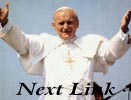
 This
Eastern Catholic Webring site is
owned by This
Eastern Catholic Webring site is
owned by"Mystic Rose". Want to join the Eastern Catholic Webring? |
|---|
| [Skip Prev] [Prev] [Next] [Skip Next] [ Random] [Next 5] [ List Sites] |

(Note: Some Roman Catholics refer to Eastern Catholics as "Uniates". However, this is actually a derogatory term, used by the Orthodox for any Eastern Christians in union with the Pope. Eastern Catholics find it offensive! Most Roman Rite Catholics use the term innocently, unaware of its negative connotation; they must be informed that it is a slur so they can avoid it in the future. Acceptable substitutes include: "Eastern Catholic", "Greek Catholic", or adjectives referring to the specific rite, such as "Melkite", "Maronite", etc.)
Each of these rites has equal status in the Church with the Roman Rite and with one another. No rite is greater than any other. No rite is "more Catholic" than any other. This is true regardless of the number of members belonging to a particular rite.
All the rites of the Catholic Church also hold the same dogmas; they are unequivocally united in faith and moral teachings, for they are all part of one Holy Mother Church. Yet their policies and practices often differ according to custom. This is a good and healthy thing; it shows that the One Truth of God can be celebrated in many different ways by various cultures.
Most of the Eastern Rites came about when members of various Eastern Churches (Orthodox, Coptic, etc.) decided to return to union with the Pope of Rome. The one exception is the Maronite Rite, which says it always recognized the Holy Father. Consequently, every Eastern Catholic rite has a corresponding Orthodox church except the Maronites.
The following is an updated list of the twenty-two Eastern rites of the Holy Catholic Church:Since we are one and the same Holy Catholic Church, there is total intercommunion between Eastern and Roman Catholics. The latter can attend a Divine Liturgy in an Eastern Catholic church, and Eastern Catholics can attend a Roman Rite Mass. This will fulfill ones Sunday or Holy Day obligation.
Byzantine Rites:
- Albanian
- Bulgarian
- Belarussian
- Croatian
- Georgian
- Greek
- Hungarian
- Italo-Greek (or Italo-Albanian)
- Melkite
- Romanian
- Russian
- Ruthenian
- Slovak
- Ukrainian
ArmenianAlexandrian Rites:
Antiochene Rites:
- Coptic
- Ge'ez (or Ethiopic)
Chaldean Rites:
- Maronite
- Syrian
- Syro-Malankar
- Chaldean
- Syro-Malabar
However, before attending an Eastern Catholic Liturgy, a Roman Catholic might want to learn some of the distinctive elements of worship in that rite. For instance, Byzantine Catholics cross themselves from the right shoulder to the left, while Roman Rite Catholics do it the opposite way (though some non-Byzantine Eastern Catholics, such the Copts, make the Sign of the Cross the same way the Roman Rite does). Neither way is "wrong" per se; just different! Yet when visiting a rite other than ones own, it is only proper that one should follow the worship customs of that rite.
I recommend that a Catholic of the Roman Rite browse some of the online Eastern Catholic pages before attending a Divine Liturgy. For instance, if one intends to visit a Ukrainian Rite Liturgy, one can first check out a few of the Ukrainian Catholic websites below, in order to get an idea of what to expect and how to act during the Liturgy.
A list of Eastern Catholic sites on the web can be found here: Links To Websites of Eastern Catholic Churches

 This
Eastern Catholic Webring site is
owned by This
Eastern Catholic Webring site is
owned by"Mystic Rose". Want to join the Eastern Catholic Webring? |
|---|
| [Skip Prev] [Prev] [Next] [Skip Next] [ Random] [Next 5] [ List Sites] |
Page last updated 16 November 1999, Feast of Saint Matthew, Apostle and Evangelist (Melkite Rite).
Background: The Ansated Cross (crux ansata) is a symbol used by Coptic Christians. The "Queen of India" Ikon comes from Our Lady's Gallery.)
| Return To Top | Next: Eastern Catholic FAQ | Joyful Catholicism| Site Index | Home Page |